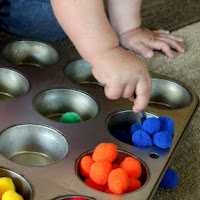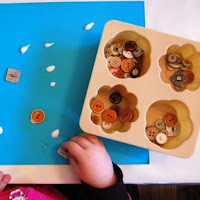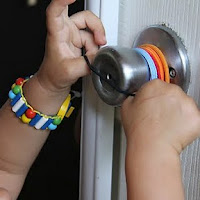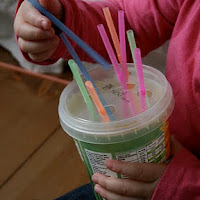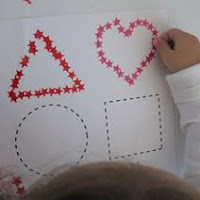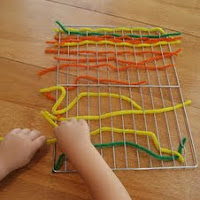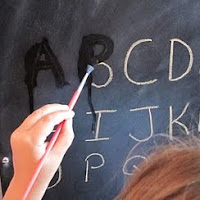http://store.positivediscipline.com/EMPOWERING-VS-ENABLING_b_31.html
Posted by Lynn Lott and Jane Nelsen on 12/5/2011 on Positive Discipline
Thursday, March 28, 2013
Tuesday, March 19, 2013
Vision & Reading
http://www.children-special-needs.org/vision_therapy/esophoria_reading.html
The following are excerpts from an article on Vision, Learning and Nutrition
by Donald J. Getz, OD, FCOVD, FAAO
This article by an eye doctor discusses children's problems with reading, learning, and behavior caused by convergence insufficiency, eye tracking problems, esophoria, exophoria, and other visual problems.
Eyesight is simply the ability to see something clearly, the so-called 20/20 eyesight (as measured in a standard eye examination with a Snellen chart). Vision goes beyond eyesight and can best be defined as the understanding of what is seen. Vision involves the ability to take incoming visual information, process that information and obtain meaning from it.
Two general statements can be made about vision. First, vision is learned. A child learns to see just like he learns to walk and talk. When learning to walk and talk, he has the added opportunity of imitating his parents and siblings. In addition, parents can observe their children to determine if walking and talking are developing properly. Vision development, however, generally proceeds without much concerned awareness on the part of parents. Because of these differences in development, no two people see exactly alike.
Vision is learned; therefore vision is trainable. If a child does not possess the necessary visual skills, he can be taught to possess them through the proper Vision Therapy techniques.
Since something like 75% to 90% of all a child learns comes to him via the visual pathways, it stands to reason that if there is any interference in those pathways, a child will not develop to his maximum potential.
Visual Acuity: There are many visual skills which are important for academic success. One of the least important skills is termed visual acuity (clarity, sharpness). This is the so-called 20/20, 20/400, etc., eyesight. All that is meant by the notation 20/20 is that a person is capable of seeing clearly at a distance of twenty feet. Unfortunately, how well a child sees at twenty feet has little to do with how his vision functions at the reading and learning distance -- aproximately eleven to sixteen inches from the face. In fact, it is my opinion that the Snellen eye chart test which measures visual acuity actually does more harm than good. It gives both parents and teachers a false sense of security that vision is normal. There are many other important visual skills that might not be developed even though visual acuity at distance is normal.
Binocular Coordination: One of the more important visual skills is the ability to coordinate the two eyes together. A child is born with two eyes, but he must learn to team them together. Some children learn to do this properly while others do not. For example, some children develop a problem known as exophoria, which is a tendency for the eyes to deviate in an outward direction. This is not the same as a condition known as exotropia where the eye actually can be seen to be in an outward position.
Adequate Convergence: During the act of reading, the demand is for the two eyes to turn inward so that they are aimed at the reading task. If the eyes have a tendency to deviate outward, the child must use excess effort and energy to maintain fixation on the reading task. Most studies have shown that the greater the amount of effort involved in reading, the lower will be the comprehension and the lower will be the performance. When reading, the eyes do not move smoothly over a line of print. Rather, they make a series of fixations looking from word to word. When an exophoria exists, each time fixation is broken and moved to the next word, the eyes will tend to deviate outwards and they must be brought back in to regain fixation. Human nature being what it is, the child generally has an avoidance reaction to the reading task. This is compounded by the fact that anything the child doesn't do well, he would rather not do. This is the child who looks out the window rather than paying visual attention. He is commonly given labels. He is often accused of having a short attention span and not trying. He is told that he would do better if he tried harder, but he has tried harder to no avail. He is often labeled as having dyslexia, minimal brain dysfunction, learning disability, etc. Commonly, he loses his place while reading and/or uses his finger or a marker to maintain his place. While making the eye movements during the act of reading, he might not land on the next word, but rather land a few words further on. Consequently, he commonly omits small words or confuses small words. Often, he just adds a word or two to make the sentence make sense. If the two eyes are pointing at the same point in space, a person will see the fixated object as being single. Double vision or overlapping vision (Figure #3) results if the two eyes are not exactly pointing at the same point. Don't expect a child to tell you that his vision isn't clear. He has no yardstick of comparison to inform him that his vision differs from the vision of anyone else.
![[ Figure 3 ]](http://www.children-special-needs.org/images/getz_fig3.gif)
Figure 3
Astigmatism, Eye-Hand Coordination, Visual-Motor Problems and more: I have maintained for many years that I could walk into a classroom and pick out those children with coordination type visual problems. They get into distorted postures in an attempt to get one eye out of the act. They often put their head down on their arm, cover one eye with their palm or rotate their head so that the bridge of their nose interferes with the vision from one eye.
Esophoria: Another eye coordination problem is termed esophoria, which is a tendency for the eyes to turn inwards. The educational implication of this particular problem is that a child with esophoria sees things smaller than what they actually are. In order to see an object properly, it is necessary to make the object larger. The only means at the disposal of the child to make it larger is to bring it closer. Eventually, the child is observed with his head buried in a book and still not achieving.
One of the tests used in optometric offices is to have the child read words while looking into an instrument called a Telebinocular. The performance is compared between reading with either eye alone and with both eyes together. The difference in performance is often quite dramatic if there is an eye teaming problem. One eye performance might be quite satisfactory, but reading with both eyes together will be slower and many more errors will be made.
Directionality: Directionality is another visual skill important for academic success. One test for this skill is illustrated in Figure #5. Look at Figure #5 and determine what you see. If the visual reflex is from left to right, a duck will be seen. However, if the visual reflex is from right to left, a rabbit will be seen. This is just one test out of a series to determine the directionality of the visual reflex.
![[ Figure 5 ]](http://www.children-special-needs.org/images/getz_fig5.gif)
Figure 5
It is just a convention of our culture that the English language proceeds in a left to right direction. Other languages proceed in a right to left direction and still others have a vertical orientation. Many people feel that it would make more sense if the language proceeded as illustrated in Figure #6. If a child does not visually proceed from left to right, through Vision Therapy he can be taught to develop this skill just like he can be taught to team his eyes together.
![[ Figure 6 ]](http://www.children-special-needs.org/images/getz_fig6.gif)
Figure 6
Form Perception: Form perception is another important visual skill for academic achievement. This can best be illustrated by referring to Figure #7. The child is shown these forms one at a time and he is simply asked to copy them. It is amazing to see some of the distortions that a child will make in attempting to copy these forms. If a child can't perceive and copy these simple geometric forms, it is unreasonable to assume that he will be able to perceive the wiggly lines which make up letters which in turn make up words, which in turn make up sentences which stand for abstract ideas. We see children often who can't tell the difference between a square and a rectangle or a circle and an oval. This is also a skill which can be improved through Vision Therapy.
![[ Figure 7 ]](http://www.children-special-needs.org/images/getz_fig7.gif)
Figure 7
Attention Span/Span of Perception: The Span of Perception is also related to success in school. Many children see just one word at a time with each eye fixation. Reading speed can be improved by learning to see two, three, or more words with each eye fixation. This could be compared to reading through a straw. This is illustrated in Figure #8. It is easy to see the difference in reading for meaning when the span of perception is wide.
![[ Figure 8 ]](http://www.children-special-needs.org/images/getz_fig8.gif)
Figure 8
Visualization: The ultimate visual skill is visualization. This is similar to being able to see things in the mind's eye. There are authorities that state that the ability to visualize is very closely allied to the ability to think. In other words, thinking is related to the ability to abstract from specifics and the ability to visualize is deeply involved in this process. Visualization is also a trainable skill.
There are many other visual skills that time and space do not permit me to mention. However, it is hoped that the reader will realize from the above discussion that there is a lot more to vision than just 20/20.
When I see a child with a learning problem, I feel very strongly that there usually is more than just a single cause. For example, when I find a visual problem, if I probe a bit further, a nutritional problem will be found as well. Children often walk into the office eating a candy bar or sipping on a cola or other soft drink. When they are asked what they had for breakfast, the response usually falls in the frosted, sugary flake category or the answer is that they had no breakfast at all.
When I am asked which nutrients are important for optimum visual functioning, I respond that the same nutrients essential for the rest of the body are the ones needed for vision. This is because vision does not operate independently of the rest of the body.
In all cases, a diet of high quality, nutrition-rich, unprocessed foods is important if we are going to be successful in Vision Therapy. Vision therapy involves a learning process and, as with any learning process, learning will be maximized if a healthy body and a healthy mind are brought to the learning task.

Reprinted with permission from The Journal of Applied Nutrition Volume 28, Winter, 1976
This complete article may be purchased by writing to College of Optometrists in Vision Development, 243 N. Lindbergh Blvd., Ste. 310, St. Louis, MO 63141-7851 and requesting the article: Getz, Donald J., O.D., "Vision and Perception Therapy," 1973.

Feingold, Ben F., M.D., Why Your Child Is Hyperactive, Random House, New York, 1975.
Lane, Benjamin. O.D., "Myopia," 1976. College of Optometrists in Vision Development
Ludlam, William, O.D., "Visual Evoked Response," 1974. College of Optometrists in Vision Development
McDonald, Lawrence W., O.D., "Visual Training," 1962-1963. Optometric Extension Program
Ott, John. Sc.D., Health and Light, The Effects of Natural and Artificial Light on Man and Other Living Things, Devin-Adair Co., 1973.
Skeffington, A.M., O.D., Continuous writings, Optometric Extension Program
To locate an eye doctor who provides comprehensive pediatric vision examinations and treatment, including Vision Therapy, request a referral through our Referral Directory: Find a Pediatric Eye Doctor.
The following are excerpts from an article on Vision, Learning and Nutrition
by Donald J. Getz, OD, FCOVD, FAAO
This article by an eye doctor discusses children's problems with reading, learning, and behavior caused by convergence insufficiency, eye tracking problems, esophoria, exophoria, and other visual problems.
Vision and Eyesight
Eyesight is simply the ability to see something clearly, the so-called 20/20 eyesight (as measured in a standard eye examination with a Snellen chart). Vision goes beyond eyesight and can best be defined as the understanding of what is seen. Vision involves the ability to take incoming visual information, process that information and obtain meaning from it.
Two general statements can be made about vision. First, vision is learned. A child learns to see just like he learns to walk and talk. When learning to walk and talk, he has the added opportunity of imitating his parents and siblings. In addition, parents can observe their children to determine if walking and talking are developing properly. Vision development, however, generally proceeds without much concerned awareness on the part of parents. Because of these differences in development, no two people see exactly alike.
Vision Is Learned
Vision is learned; therefore vision is trainable. If a child does not possess the necessary visual skills, he can be taught to possess them through the proper Vision Therapy techniques.
Adequate Vision Is Critical to Learning
Since something like 75% to 90% of all a child learns comes to him via the visual pathways, it stands to reason that if there is any interference in those pathways, a child will not develop to his maximum potential.
Vision
The Visual Skills Needed for Academic Success
Visual Acuity: There are many visual skills which are important for academic success. One of the least important skills is termed visual acuity (clarity, sharpness). This is the so-called 20/20, 20/400, etc., eyesight. All that is meant by the notation 20/20 is that a person is capable of seeing clearly at a distance of twenty feet. Unfortunately, how well a child sees at twenty feet has little to do with how his vision functions at the reading and learning distance -- aproximately eleven to sixteen inches from the face. In fact, it is my opinion that the Snellen eye chart test which measures visual acuity actually does more harm than good. It gives both parents and teachers a false sense of security that vision is normal. There are many other important visual skills that might not be developed even though visual acuity at distance is normal.
Binocular Coordination: One of the more important visual skills is the ability to coordinate the two eyes together. A child is born with two eyes, but he must learn to team them together. Some children learn to do this properly while others do not. For example, some children develop a problem known as exophoria, which is a tendency for the eyes to deviate in an outward direction. This is not the same as a condition known as exotropia where the eye actually can be seen to be in an outward position.
Adequate Convergence: During the act of reading, the demand is for the two eyes to turn inward so that they are aimed at the reading task. If the eyes have a tendency to deviate outward, the child must use excess effort and energy to maintain fixation on the reading task. Most studies have shown that the greater the amount of effort involved in reading, the lower will be the comprehension and the lower will be the performance. When reading, the eyes do not move smoothly over a line of print. Rather, they make a series of fixations looking from word to word. When an exophoria exists, each time fixation is broken and moved to the next word, the eyes will tend to deviate outwards and they must be brought back in to regain fixation. Human nature being what it is, the child generally has an avoidance reaction to the reading task. This is compounded by the fact that anything the child doesn't do well, he would rather not do. This is the child who looks out the window rather than paying visual attention. He is commonly given labels. He is often accused of having a short attention span and not trying. He is told that he would do better if he tried harder, but he has tried harder to no avail. He is often labeled as having dyslexia, minimal brain dysfunction, learning disability, etc. Commonly, he loses his place while reading and/or uses his finger or a marker to maintain his place. While making the eye movements during the act of reading, he might not land on the next word, but rather land a few words further on. Consequently, he commonly omits small words or confuses small words. Often, he just adds a word or two to make the sentence make sense. If the two eyes are pointing at the same point in space, a person will see the fixated object as being single. Double vision or overlapping vision (Figure #3) results if the two eyes are not exactly pointing at the same point. Don't expect a child to tell you that his vision isn't clear. He has no yardstick of comparison to inform him that his vision differs from the vision of anyone else.
![[ Figure 3 ]](http://www.children-special-needs.org/images/getz_fig3.gif)
Figure 3
Astigmatism, Eye-Hand Coordination, Visual-Motor Problems and more: I have maintained for many years that I could walk into a classroom and pick out those children with coordination type visual problems. They get into distorted postures in an attempt to get one eye out of the act. They often put their head down on their arm, cover one eye with their palm or rotate their head so that the bridge of their nose interferes with the vision from one eye.
Esophoria: Another eye coordination problem is termed esophoria, which is a tendency for the eyes to turn inwards. The educational implication of this particular problem is that a child with esophoria sees things smaller than what they actually are. In order to see an object properly, it is necessary to make the object larger. The only means at the disposal of the child to make it larger is to bring it closer. Eventually, the child is observed with his head buried in a book and still not achieving.
Reading Skills and Binocular Visual Skills
One of the tests used in optometric offices is to have the child read words while looking into an instrument called a Telebinocular. The performance is compared between reading with either eye alone and with both eyes together. The difference in performance is often quite dramatic if there is an eye teaming problem. One eye performance might be quite satisfactory, but reading with both eyes together will be slower and many more errors will be made.
Other Visual Skills
Directionality: Directionality is another visual skill important for academic success. One test for this skill is illustrated in Figure #5. Look at Figure #5 and determine what you see. If the visual reflex is from left to right, a duck will be seen. However, if the visual reflex is from right to left, a rabbit will be seen. This is just one test out of a series to determine the directionality of the visual reflex.
![[ Figure 5 ]](http://www.children-special-needs.org/images/getz_fig5.gif)
Figure 5
It is just a convention of our culture that the English language proceeds in a left to right direction. Other languages proceed in a right to left direction and still others have a vertical orientation. Many people feel that it would make more sense if the language proceeded as illustrated in Figure #6. If a child does not visually proceed from left to right, through Vision Therapy he can be taught to develop this skill just like he can be taught to team his eyes together.
![[ Figure 6 ]](http://www.children-special-needs.org/images/getz_fig6.gif)
Figure 6
Form Perception: Form perception is another important visual skill for academic achievement. This can best be illustrated by referring to Figure #7. The child is shown these forms one at a time and he is simply asked to copy them. It is amazing to see some of the distortions that a child will make in attempting to copy these forms. If a child can't perceive and copy these simple geometric forms, it is unreasonable to assume that he will be able to perceive the wiggly lines which make up letters which in turn make up words, which in turn make up sentences which stand for abstract ideas. We see children often who can't tell the difference between a square and a rectangle or a circle and an oval. This is also a skill which can be improved through Vision Therapy.
![[ Figure 7 ]](http://www.children-special-needs.org/images/getz_fig7.gif)
Figure 7
Attention Span/Span of Perception: The Span of Perception is also related to success in school. Many children see just one word at a time with each eye fixation. Reading speed can be improved by learning to see two, three, or more words with each eye fixation. This could be compared to reading through a straw. This is illustrated in Figure #8. It is easy to see the difference in reading for meaning when the span of perception is wide.
![[ Figure 8 ]](http://www.children-special-needs.org/images/getz_fig8.gif)
Figure 8
Visualization: The ultimate visual skill is visualization. This is similar to being able to see things in the mind's eye. There are authorities that state that the ability to visualize is very closely allied to the ability to think. In other words, thinking is related to the ability to abstract from specifics and the ability to visualize is deeply involved in this process. Visualization is also a trainable skill.
There are many other visual skills that time and space do not permit me to mention. However, it is hoped that the reader will realize from the above discussion that there is a lot more to vision than just 20/20.
Nutrition and Vision
When I see a child with a learning problem, I feel very strongly that there usually is more than just a single cause. For example, when I find a visual problem, if I probe a bit further, a nutritional problem will be found as well. Children often walk into the office eating a candy bar or sipping on a cola or other soft drink. When they are asked what they had for breakfast, the response usually falls in the frosted, sugary flake category or the answer is that they had no breakfast at all.
When I am asked which nutrients are important for optimum visual functioning, I respond that the same nutrients essential for the rest of the body are the ones needed for vision. This is because vision does not operate independently of the rest of the body.
In all cases, a diet of high quality, nutrition-rich, unprocessed foods is important if we are going to be successful in Vision Therapy. Vision therapy involves a learning process and, as with any learning process, learning will be maximized if a healthy body and a healthy mind are brought to the learning task.
Reprinted with permission from The Journal of Applied Nutrition Volume 28, Winter, 1976
This complete article may be purchased by writing to College of Optometrists in Vision Development, 243 N. Lindbergh Blvd., Ste. 310, St. Louis, MO 63141-7851 and requesting the article: Getz, Donald J., O.D., "Vision and Perception Therapy," 1973.
Bibliography
Feingold, Ben F., M.D., Why Your Child Is Hyperactive, Random House, New York, 1975.
Lane, Benjamin. O.D., "Myopia," 1976. College of Optometrists in Vision Development
Ludlam, William, O.D., "Visual Evoked Response," 1974. College of Optometrists in Vision Development
McDonald, Lawrence W., O.D., "Visual Training," 1962-1963. Optometric Extension Program
Ott, John. Sc.D., Health and Light, The Effects of Natural and Artificial Light on Man and Other Living Things, Devin-Adair Co., 1973.
Skeffington, A.M., O.D., Continuous writings, Optometric Extension Program
To locate an eye doctor who provides comprehensive pediatric vision examinations and treatment, including Vision Therapy, request a referral through our Referral Directory: Find a Pediatric Eye Doctor.
Monday, March 11, 2013
Coping Strategies for Children with Learning Disabilities: Enhancing Skills for Success in Life
http://www.ncld.org/ld-basics/ld-aamp-social-skills/social-aamp-emotional-challenges/coping-strategies-and-ld-enhancing-skills-for-success-in-life

By Annie Stuart
The secret to success seems elusive to many people. Is there really a reliable roadmap to health and happiness? And if you have a learning disability (LD), do you need take a different course? Not really. Although research has identified several attributes that form the foundation of life success for people with LD, you'll likely recognize the universal relevance of many of these traits, such as perseverance and proactivity. Another is the use of healthy coping strategies, the topic of this article.
Here are six things to keep in mind as you teach your child with LD how to navigate the ups and downs of his or her own emotional terrain.
1. Get your own house in order. If you're anxious about your child's learning disability, if you're fearful about his or her future, if you find yourself tearing your hair out every time you turn around, then you may need to first take a look at your own coping strategies. How do you handle stress? What messages are you sending yourself about your parenting skills? What kind of support system do you have in place?
If you learn to relax and better address your own emotional challenges, you'll be doing yourself and your whole family a big favor. Remember the flight attendant's advice: Put the oxygen mask on yourself before you put it on your child. Doing so helps you to breathe, to accept your child's differences, and to build on his or her strengths. Yes, it's true a child with LD may never be a great reader, but many successful people – from Greg Louganis to Whoopi Goldberg to Richard Branson – have had LD and they've done just fine – in fact, better than fine.
2. Use and teach a vocabulary of emotions. You want your child to know what it means to have empathy for others or to demonstrate gratitude or to savor nature's beauty. In addition to modeling behaviors like these, name and praise these positive behaviors when you see them in your child. This will help cultivate a sense of emotional awareness and sensitivity.
Likewise, kids need to also know how to name negative emotions. Ask what stress feels like for them, where they notice it in their bodies, and what they think might have caused it. This isn't always an easy exercise, particularly for a child with language-processing issues, says Chris Schnieders, Ph.D., director of teacher training at the Frostig School. It takes some work to figure this all out, and that's where a parent’s gentle questioning and calm explanations can make a difference.
3. Recognize — and trip up — the triggers. The better your child gets at recognizing stress triggers, the more successful he or she will be at handling life's curve balls. Research underscores this point, says Frostig researcher Roberta J. Goldberg, Ph.D. All children in the Frostig success studies1,2 had been greatly challenged by anxiety or stress — largely as a result of LD, she says. "But the ones who recognized stress triggers, especially of LD, and demonstrated coping strategies were the most successful."
Goldberg admits that it can be difficult to know how to help your child identify his or her own triggers, but with time, he can recognize the signs. Do you know what your child's triggers are? Being asked to turn off the TV? Making transitions from one activity to another? Getting stuck on a math problem? Talk about these with your child and problem solve ways to "cut them off at the pass" — before your child's stress hormones go into overdrive. If the problem is television or transitions, maybe you agree on five-minute warnings before turning off the TV or you make sure your child has plenty of down time between activities.
What about your child's coping mechanisms? You'd be surprised at how much your child has intuitively figured out. Help support healthy ways of coping. It's idiosyncratic, says Goldberg, so the options are practically unlimited. Is music soothing to your child? Then listening to an iPod may not be an idle activity — even when doing homework. Does your child enjoy texting friends? Well, then those messages — within limits — might bring a helpful distraction. Or maybe writing in a journal or a walk in the woods has a calming effect on your child.
Look for signs of stress and intervene when your child is unable to do this for herself. If she's been hitting the books for two hours and is starting to unravel, you might want to enforce a trampoline break, or jumping jacks, or at the very least, some deep breathing.
"My son — who's now a mechanical engineer — struggled in school and had meltdowns in college," says Goldberg. "I didn't say, 'Go study.' I'd tell him to go for a run or swim 22 laps. I knew those were his coping mechanisms."
And, don't forget to play to your child's strengths. If sports, music, or theatre is his strong suit, then allowing time for these pursuits can greatly enhance self-confidence and positive coping behaviors.
4. Make coping strategies concrete. If your child struggles with developing specific coping mechanisms, try priming the pump with some questions like these:
Depending upon your child's age and personality, don't necessarily expect (or request) a direct answer to these questions. You can simply throw these out as food for thought. This may help your child describe and acknowledge — if only to himself — what works best for him. And this will take him a step closer to actually using these concrete strategies.
5. Learn healthy ways to communicate. Jeff Rice is principal of one of the Briarwood Schools in Houston, TX, serving students with LD and developmental delays. He reminds parents that the normal teen mentality is to interact as little as possible with adults, especially parents. "It may seem like you've got a stranger living in your home, but trust me, they will come around," says Rice. And, he tells parents they'd be amazed if they knew how often kids identify parents as their "go-to person" in times of trouble.
Rice suggests tips like these for moving toward healthier communication with kids.
6. Seek outside help when needed. Remember that a big part of having a healthy coping strategy is knowing how to find and use support systems. For example, if your child is falling behind in math, a tutor may help in more ways than one — by not only shoring up academic weak links, but also circumventing power struggles over homework. And, if your child struggles with anxiety or depression, seeking outside resources such as counseling may be in order. Remember that you cannot be all things to your child.
Help your child identify both internal and external sources of support for better coping. And, do the same for yourself. This can be critical for developing a healthy approach to emotional challenges — which, as you know, won't disappear with adulthood!
2 Goldberg, R.J. et al. Learning Disabilities Research and Practice. 2003; 18(4): 222–236.
Annie Stuart is a freelance writer and editor with nearly 25 years of experience. She specializes in consumer health, parenting, and learning disabilities, among other areas.
This article is made possible by a grant from the American Legion Child Welfare Foundation.

By Annie Stuart
The secret to success seems elusive to many people. Is there really a reliable roadmap to health and happiness? And if you have a learning disability (LD), do you need take a different course? Not really. Although research has identified several attributes that form the foundation of life success for people with LD, you'll likely recognize the universal relevance of many of these traits, such as perseverance and proactivity. Another is the use of healthy coping strategies, the topic of this article.
Here are six things to keep in mind as you teach your child with LD how to navigate the ups and downs of his or her own emotional terrain.
1. Get your own house in order. If you're anxious about your child's learning disability, if you're fearful about his or her future, if you find yourself tearing your hair out every time you turn around, then you may need to first take a look at your own coping strategies. How do you handle stress? What messages are you sending yourself about your parenting skills? What kind of support system do you have in place?
If you learn to relax and better address your own emotional challenges, you'll be doing yourself and your whole family a big favor. Remember the flight attendant's advice: Put the oxygen mask on yourself before you put it on your child. Doing so helps you to breathe, to accept your child's differences, and to build on his or her strengths. Yes, it's true a child with LD may never be a great reader, but many successful people – from Greg Louganis to Whoopi Goldberg to Richard Branson – have had LD and they've done just fine – in fact, better than fine.
2. Use and teach a vocabulary of emotions. You want your child to know what it means to have empathy for others or to demonstrate gratitude or to savor nature's beauty. In addition to modeling behaviors like these, name and praise these positive behaviors when you see them in your child. This will help cultivate a sense of emotional awareness and sensitivity.
Likewise, kids need to also know how to name negative emotions. Ask what stress feels like for them, where they notice it in their bodies, and what they think might have caused it. This isn't always an easy exercise, particularly for a child with language-processing issues, says Chris Schnieders, Ph.D., director of teacher training at the Frostig School. It takes some work to figure this all out, and that's where a parent’s gentle questioning and calm explanations can make a difference.
3. Recognize — and trip up — the triggers. The better your child gets at recognizing stress triggers, the more successful he or she will be at handling life's curve balls. Research underscores this point, says Frostig researcher Roberta J. Goldberg, Ph.D. All children in the Frostig success studies1,2 had been greatly challenged by anxiety or stress — largely as a result of LD, she says. "But the ones who recognized stress triggers, especially of LD, and demonstrated coping strategies were the most successful."
Goldberg admits that it can be difficult to know how to help your child identify his or her own triggers, but with time, he can recognize the signs. Do you know what your child's triggers are? Being asked to turn off the TV? Making transitions from one activity to another? Getting stuck on a math problem? Talk about these with your child and problem solve ways to "cut them off at the pass" — before your child's stress hormones go into overdrive. If the problem is television or transitions, maybe you agree on five-minute warnings before turning off the TV or you make sure your child has plenty of down time between activities.
What about your child's coping mechanisms? You'd be surprised at how much your child has intuitively figured out. Help support healthy ways of coping. It's idiosyncratic, says Goldberg, so the options are practically unlimited. Is music soothing to your child? Then listening to an iPod may not be an idle activity — even when doing homework. Does your child enjoy texting friends? Well, then those messages — within limits — might bring a helpful distraction. Or maybe writing in a journal or a walk in the woods has a calming effect on your child.
Look for signs of stress and intervene when your child is unable to do this for herself. If she's been hitting the books for two hours and is starting to unravel, you might want to enforce a trampoline break, or jumping jacks, or at the very least, some deep breathing.
"My son — who's now a mechanical engineer — struggled in school and had meltdowns in college," says Goldberg. "I didn't say, 'Go study.' I'd tell him to go for a run or swim 22 laps. I knew those were his coping mechanisms."
And, don't forget to play to your child's strengths. If sports, music, or theatre is his strong suit, then allowing time for these pursuits can greatly enhance self-confidence and positive coping behaviors.
4. Make coping strategies concrete. If your child struggles with developing specific coping mechanisms, try priming the pump with some questions like these:
- If you were having a problem, who would you talk to?
- What are the fun things or activities that you like to do when you are sad or down?
- What motivates you? In other words, why do you do what you do?
- How do you handle peer pressure? For example, what would you do if a friend or peer asked you to try drugs?
- Who are your role models or people you look up to?
Depending upon your child's age and personality, don't necessarily expect (or request) a direct answer to these questions. You can simply throw these out as food for thought. This may help your child describe and acknowledge — if only to himself — what works best for him. And this will take him a step closer to actually using these concrete strategies.
5. Learn healthy ways to communicate. Jeff Rice is principal of one of the Briarwood Schools in Houston, TX, serving students with LD and developmental delays. He reminds parents that the normal teen mentality is to interact as little as possible with adults, especially parents. "It may seem like you've got a stranger living in your home, but trust me, they will come around," says Rice. And, he tells parents they'd be amazed if they knew how often kids identify parents as their "go-to person" in times of trouble.
Rice suggests tips like these for moving toward healthier communication with kids.
- Ask open-ended questions. Don't be satisfied with the curtness of a yes-no response from your child. You can get around this by asking open-ended questions like: What was the most surprising thing that happened at school today? Or: What was the school assembly all about? Or: What was something you did to manage your stress? A longer response provides a better opening for give and take. Without lecturing, you're also modeling the art of conversation. Just remember that with open-ended questions, you'll also need to stay open — without judgment — to your child's fears, frustrations, and failures.
- Be present. Even more important than questioning is simply being present and listening. When your child is talking with you, don't get distracted by opening bills or checking your phone messages. If you do, you're communicating — without saying a word — that something else is more important. And, though there's a place for "history lessons," don't always cut in with responses like, "Well, when I was a kid…." Checking in and displaying empathic listening can often go so much further.
- Reflect back what your child says. Restate what your child has said, in his or her own words — not yours. You might say: "What I'm understanding is that you felt bullied today at lunch…." Again, this helps your child feel heard and understood.
6. Seek outside help when needed. Remember that a big part of having a healthy coping strategy is knowing how to find and use support systems. For example, if your child is falling behind in math, a tutor may help in more ways than one — by not only shoring up academic weak links, but also circumventing power struggles over homework. And, if your child struggles with anxiety or depression, seeking outside resources such as counseling may be in order. Remember that you cannot be all things to your child.
Help your child identify both internal and external sources of support for better coping. And, do the same for yourself. This can be critical for developing a healthy approach to emotional challenges — which, as you know, won't disappear with adulthood!
Sources
1 Raskind, M.H. et al. Learning Disabilities Research and Practice. 1999; 14(1): 35–49.2 Goldberg, R.J. et al. Learning Disabilities Research and Practice. 2003; 18(4): 222–236.
Annie Stuart is a freelance writer and editor with nearly 25 years of experience. She specializes in consumer health, parenting, and learning disabilities, among other areas.
This article is made possible by a grant from the American Legion Child Welfare Foundation.
Sunday, March 10, 2013
How Inefficient Visual Processing Can Affect a Student's School Performance
From The Vision Therapy Center
Published on Feb 21, 2013
Dr. Kellye Knueppel of The Vision Therapy Center discusses how vision problems affect each academic subject, including reading, composition, math and handwriting.
Sunday, February 24, 2013
Three Huge Mistakes We Make Leading Kids
...and How to Correct Them
February 15, 2013

by Tim Elmore
Recently, I read about a father, Paul Wallich, who built a camera-mounted drone helicopter to follow his grade-school-aged son to the bus stop. He wants to make sure his son arrives at the bus stop safe and sound. There’s no doubt the gizmo provides an awesome show-and-tell contribution. In my mind, Paul Wallich gives new meaning to the term “helicopter parent.”
While I applaud the engagement of this generation of parents and teachers, it’s important to recognize the unintended consequences of our engagement. We want the best for our students, but research now shows that our “over-protection, over-connection” style has damaged them. Let me suggest three huge mistakes we’ve made leading this generation of kids and how we must correct them.

Author Gever Tulley suggests, “If you’re over 30, you probably walked to school, played on the monkey bars, and learned to high-dive at the public pool. If you’re younger, it’s unlikely you did any of these things. Yet, has the world become that much more dangerous? Statistically, no. But our society has created pervasive fears about letting kids be independent—and the consequences for our kids are serious.”
Unfortunately, over-protecting our young people has had an adverse effect on them.
“Children of risk-averse parents have lower test scores and are slightly less likely to attend college than offspring of parents with more tolerant attitudes toward risk,” says a team led by Sarah Brown of the University of Sheffield in the UK. Aversion to risk may prevent parents from making inherently uncertain investments in their children’s human capital; it’s also possible that risk attitudes reflect cognitive ability, researchers say.” Sadly, this Scottish Journal of Political Economy report won’t help us unless we do something about it. Adults continue to vote to remove playground equipment from parks so kids won’t have accidents; to request teachers stop using red ink as they grade papers and even cease from using the word “no” in class. It’s all too negative. I’m sorry—but while I understand the intent to protect students, we are failing miserably at preparing them for a world that will not be risk-free.
Psychologists in Europe have discovered that if a child doesn’t play outside and is never allowed to experience a skinned knee or a broken bone, they frequently have phobias as adults. Interviews with young adults who never played on jungle gyms reveal they’re fearful of normal risks and commitment. The truth is, kids need to fall a few times to learn it is normal; teens likely need to break up with a boyfriend or girlfriend to appreciate the emotional maturity that lasting relationships require. Pain is actually a necessary teacher. Consider your body for a moment. If you didn’t feel pain, you could burn yourself or step on a nail and never do something about the damage and infection until it was too late. Pain is a part of health and maturity.
Similarly, taking calculated risks is all a part of growing up. In fact, it plays a huge role. Childhood may be about safety and self-esteem, but as a student matures, risk and achievement are necessities in forming their identity and confidence. Because parents have removed “risk” from children’s lives, psychologists are discovering a syndrome as they counsel teens: High Arrogance, Low Self-Esteem. They’re cocky, but deep down their confidence is hollow, because it’s built off of watching YouTube videos, and perhaps not achieving something meaningful.
According to a study by University College London, risk-taking behavior peeks during adolescence. Teens are apt to take more risks than any other age group. Their brain programs them to do so. It’s part of growing up. They must test boundaries, values and find their identity during these years. This is when they must learn, via experience, the consequences of certain behaviors. Our failure to let them risk may explain why so many young adults, between the ages of 22 and 35 still live at home or haven’t started their careers, or had a serious relationship. Normal risk taking at fourteen or fifteen would have prepared them for such decisions and the risks of moving away from home, launching a career or getting married.
Staff from four universities recently told me they encountered students who had never filled out a form or an application in their life. Desiring to care for their kids, and not disadvantage them, parents or teachers had always done it for them.
One freshman received a C- on her project and immediately called her mother, right in the middle of her class. After interrupting the class discussion with her complaint about her poor grade, she handed the cell phone to her professor and said, “She wants to talk to you.” Evidently, mom wanted to negotiate the grade.
A Harvard Admissions Counselor reported a prospective student looked him in the eye and answered every question he was asked. The counselor felt the boy’s mother must have coached him on eye-contact because he tended to look down after each response. Later, the counselor learned the boy’s mom was texting him the answers every time a question came in.
A college president said a mother of one of his students called him, saying she’d seen that the weather would be cold that day and wondered if he would make sure her son was wearing his sweater as he went to class. She wasn’t joking.
This may sound harsh, but rescuing and over-indulging our children is one of the most insidious forms of child abuse. It’s “parenting for the short-term” and it sorely misses the point of leadership—to equip our young people to do it without help. Just like muscles atrophy inside of a cast due to disuse, their social, emotional, spiritual and intellectual muscles can shrink because they’re not exercised. For example, I remember when and where I learned the art of conflict resolution. I was eleven years old, and everyday about fifteen boys would gather after school to play baseball. We would choose sides and umpire our games. Through that consistent exercise, I learned to resolve conflict. I had to. Today, if the kids are outside at all, there are likely four mothers present doing the conflict resolution for them.
The fact is, as students experience adults doing so much for them, they like it at first. Who wouldn’t? They learn to play parents against each other, they learn to negotiate with faculty for more time, lenient rules, extra credit and easier grades. This actually confirms that these kids are not stupid. They learn to play the game. Sooner or later, they know “someone will rescue me.” If I fail or “act out,” an adult will smooth things over and remove any consequences for my misconduct. Once again, this isn’t even remotely close to how the world works. It actually disables our kids.
What’s more, kids eventually observe that “mom” is the only one who thinks they’re “awesome.” No one else is saying it. They begin to doubt the objectivity of their own mother; it feels good in the moment, but it’s not connected to reality.
Further, Dr. Robert Cloninger, at Washington University in St. Louis has done brain research on the prefrontal cortex, which monitors the reward center of the brain. He says the brain has to learn that frustrating spells can be worked through. The reward center of our brains learns to say: Don’t give up. Don’t stop trying. “A person who grows up getting too frequent rewards,” Cloninger says, “will not have persistence, because they’ll quit when the rewards disappear.”
When we rave too easily, kids eventually learn to cheat, to exaggerate and lie and to avoid difficult reality. They have not been conditioned to face it. A helpful metaphor when considering this challenge is: inoculation. When you get inoculated, a nurse injects a vaccine, which actually exposes you to a dose of the very disease your body must learn to overcome. It’s a good thing. Only then do we develop an immunity to it. Similarly, our kids must be inoculated with doses of hardship, delay, challenges and inconvenience to build the strength to stand in them.
Obviously, negative risk taking should be discouraged, such as smoking, alcohol, illegal drugs, etc. In addition, there will be times our young people do need our help, or affirmation. But—healthy teens are going to want to spread their wings. They’ll need to try things on their own. And we, the adults, must let them. Here are some simple ideas you can employ as you navigate these waters:
February 15, 2013

by Tim Elmore
Recently, I read about a father, Paul Wallich, who built a camera-mounted drone helicopter to follow his grade-school-aged son to the bus stop. He wants to make sure his son arrives at the bus stop safe and sound. There’s no doubt the gizmo provides an awesome show-and-tell contribution. In my mind, Paul Wallich gives new meaning to the term “helicopter parent.”
While I applaud the engagement of this generation of parents and teachers, it’s important to recognize the unintended consequences of our engagement. We want the best for our students, but research now shows that our “over-protection, over-connection” style has damaged them. Let me suggest three huge mistakes we’ve made leading this generation of kids and how we must correct them.

1. We Risk Too Little
We live in a world that warns us of danger at every turn. Toxic. High voltage. Flammable. Slippery when wet. Steep curve ahead. Don’t walk. Hazard. This “safety first” preoccupation emerged over thirty years ago with the Tylenol scare and with children’s faces appearing on milk cartons. We became fearful of losing our kids. So we put knee-pads, safety belts and helmets on them…at the dinner table. (Actually I’m just kidding on that one). But, it’s true. We’ve insulated our kids from risk.Author Gever Tulley suggests, “If you’re over 30, you probably walked to school, played on the monkey bars, and learned to high-dive at the public pool. If you’re younger, it’s unlikely you did any of these things. Yet, has the world become that much more dangerous? Statistically, no. But our society has created pervasive fears about letting kids be independent—and the consequences for our kids are serious.”
Unfortunately, over-protecting our young people has had an adverse effect on them.
“Children of risk-averse parents have lower test scores and are slightly less likely to attend college than offspring of parents with more tolerant attitudes toward risk,” says a team led by Sarah Brown of the University of Sheffield in the UK. Aversion to risk may prevent parents from making inherently uncertain investments in their children’s human capital; it’s also possible that risk attitudes reflect cognitive ability, researchers say.” Sadly, this Scottish Journal of Political Economy report won’t help us unless we do something about it. Adults continue to vote to remove playground equipment from parks so kids won’t have accidents; to request teachers stop using red ink as they grade papers and even cease from using the word “no” in class. It’s all too negative. I’m sorry—but while I understand the intent to protect students, we are failing miserably at preparing them for a world that will not be risk-free.
Psychologists in Europe have discovered that if a child doesn’t play outside and is never allowed to experience a skinned knee or a broken bone, they frequently have phobias as adults. Interviews with young adults who never played on jungle gyms reveal they’re fearful of normal risks and commitment. The truth is, kids need to fall a few times to learn it is normal; teens likely need to break up with a boyfriend or girlfriend to appreciate the emotional maturity that lasting relationships require. Pain is actually a necessary teacher. Consider your body for a moment. If you didn’t feel pain, you could burn yourself or step on a nail and never do something about the damage and infection until it was too late. Pain is a part of health and maturity.
Similarly, taking calculated risks is all a part of growing up. In fact, it plays a huge role. Childhood may be about safety and self-esteem, but as a student matures, risk and achievement are necessities in forming their identity and confidence. Because parents have removed “risk” from children’s lives, psychologists are discovering a syndrome as they counsel teens: High Arrogance, Low Self-Esteem. They’re cocky, but deep down their confidence is hollow, because it’s built off of watching YouTube videos, and perhaps not achieving something meaningful.
According to a study by University College London, risk-taking behavior peeks during adolescence. Teens are apt to take more risks than any other age group. Their brain programs them to do so. It’s part of growing up. They must test boundaries, values and find their identity during these years. This is when they must learn, via experience, the consequences of certain behaviors. Our failure to let them risk may explain why so many young adults, between the ages of 22 and 35 still live at home or haven’t started their careers, or had a serious relationship. Normal risk taking at fourteen or fifteen would have prepared them for such decisions and the risks of moving away from home, launching a career or getting married.
2. We Rescue Too Quickly
This generation of young people has not developed some of the life skills kids did thirty years ago because adults swoop in and take care of problems for them. We remove the need for them to navigate hardships. May I illustrate?Staff from four universities recently told me they encountered students who had never filled out a form or an application in their life. Desiring to care for their kids, and not disadvantage them, parents or teachers had always done it for them.
One freshman received a C- on her project and immediately called her mother, right in the middle of her class. After interrupting the class discussion with her complaint about her poor grade, she handed the cell phone to her professor and said, “She wants to talk to you.” Evidently, mom wanted to negotiate the grade.
A Harvard Admissions Counselor reported a prospective student looked him in the eye and answered every question he was asked. The counselor felt the boy’s mother must have coached him on eye-contact because he tended to look down after each response. Later, the counselor learned the boy’s mom was texting him the answers every time a question came in.
A college president said a mother of one of his students called him, saying she’d seen that the weather would be cold that day and wondered if he would make sure her son was wearing his sweater as he went to class. She wasn’t joking.
This may sound harsh, but rescuing and over-indulging our children is one of the most insidious forms of child abuse. It’s “parenting for the short-term” and it sorely misses the point of leadership—to equip our young people to do it without help. Just like muscles atrophy inside of a cast due to disuse, their social, emotional, spiritual and intellectual muscles can shrink because they’re not exercised. For example, I remember when and where I learned the art of conflict resolution. I was eleven years old, and everyday about fifteen boys would gather after school to play baseball. We would choose sides and umpire our games. Through that consistent exercise, I learned to resolve conflict. I had to. Today, if the kids are outside at all, there are likely four mothers present doing the conflict resolution for them.
The fact is, as students experience adults doing so much for them, they like it at first. Who wouldn’t? They learn to play parents against each other, they learn to negotiate with faculty for more time, lenient rules, extra credit and easier grades. This actually confirms that these kids are not stupid. They learn to play the game. Sooner or later, they know “someone will rescue me.” If I fail or “act out,” an adult will smooth things over and remove any consequences for my misconduct. Once again, this isn’t even remotely close to how the world works. It actually disables our kids.
3. We Rave Too Easily
The self-esteem movement has been around since Baby Boomers were kids, but it took root in our school systems in the 1980s. We determined every kid would feel special, regardless of what they did, which meant they began hearing remarks like:- “You’re awesome!”
- “You’re smart.”
- “You’re gifted.”
- “You’re super!”
What’s more, kids eventually observe that “mom” is the only one who thinks they’re “awesome.” No one else is saying it. They begin to doubt the objectivity of their own mother; it feels good in the moment, but it’s not connected to reality.
Further, Dr. Robert Cloninger, at Washington University in St. Louis has done brain research on the prefrontal cortex, which monitors the reward center of the brain. He says the brain has to learn that frustrating spells can be worked through. The reward center of our brains learns to say: Don’t give up. Don’t stop trying. “A person who grows up getting too frequent rewards,” Cloninger says, “will not have persistence, because they’ll quit when the rewards disappear.”
When we rave too easily, kids eventually learn to cheat, to exaggerate and lie and to avoid difficult reality. They have not been conditioned to face it. A helpful metaphor when considering this challenge is: inoculation. When you get inoculated, a nurse injects a vaccine, which actually exposes you to a dose of the very disease your body must learn to overcome. It’s a good thing. Only then do we develop an immunity to it. Similarly, our kids must be inoculated with doses of hardship, delay, challenges and inconvenience to build the strength to stand in them.
Eight Steps Toward Healthy Leadership
- Help them take calculated risks. Talk it over with them, but let them do it. Your primary job is to prepare your child for how the world really works.
- Discuss how they must learn to make choices. They must prepare to both win and lose, not get all they want and to face the consequences of their decisions.
- Share your own “risky” experiences from your teen years. Interpret them. Because we’re not the only influence on these kids, we must be the best influence.
- Instead of tangible rewards, how about spending some time together? Be careful you aren’t teaching them that emotions can be healed by a trip to the mall.
- Choose a positive risk taking option and launch kids into it (i.e. sports, jobs, etc). It may take a push but get them used to trying out new opportunities.
- Don’t let your guilt get in the way of leading well. Your job is not to make yourself feel good by giving kids what makes them or you feel better when you give it.
- Don’t reward basics that life requires. If your relationship is based on material rewards, kids will experience neither intrinsic motivation nor unconditional love.
- Affirm smart risk-taking and hard work wisely. Help them see the advantage of both of these, and that stepping out a comfort zone usually pays off.
Labels:
children and risks,
leadership,
parenting,
Tim Elmore
The New Brain Science of Learning:
Dr. Martha S. Burns at TEDxEnola
Dr. Burns summarizes some of the new information in Neuroscience as it relates to how children learn.

Dr. Burns summarizes some of the new information in Neuroscience as it relates to how children learn.

Labels:
Dr. Burns,
how children learn,
neuroscience,
New Brain Science
Wednesday, February 20, 2013
Brain Development Could Suffer as Cursive Writing Fades
http://kstp.com/news/stories/s2935982.shtml
http://www.kstp.com/article/12303/?vid=3946948&v=1
watch video of news story by clicking on link above
The signature and cursive handwriting are in danger of fading away. In Minnesota, schools are no longer required to teach cursive. But it's not just the signature that's taking a hit, the way students learn and how their brains develop could suffer.
Maria Theissen uses the latest technology to teach her third-grade class old fashioned cursive handwriting at Concord Elementary in Edina. She says "it's about the marriage of technology. The old school and the new school have to come together." But they appear headed for divorce. Several states including Illinois, Indiana and Hawaii don't teach cursive.
Minnesota no longer requires schools to teach cursive. The Department of Education says most
districts still choose to teach it, but they spent less time on the cursive - kids are using keyboards much more.
The state follows a national standard called the Common Core. It says students must know keyboarding by fifth grade, but doesn't even mention cursive. At least 46 states have adopted the standards.
Most Minnesota kids are learning cursive in second or third grade, but by fifth grade they turn to typing full time. Most never have to look back.
Researchers say it's not about whether typing or cursive is more important. Learning cursive actually helps a child's brain development.
Doctors at Indiana University used MRI's to look at children's brains and found more activity when they were writing versus typing and researchers from Vanderbilt got similar results, seeing kids brains light up less in front of a keyboard. Doctors say cursive handwriting, more than printing, stimulates intelligence and language fluency. Fluent writing keeps kids from truncating their thoughts.
The Department of Education says they are always reevaluating their policies. They may reexamine their cursive policy if schools stop using it.
http://www.kstp.com/article/12303/?vid=3946948&v=1
watch video of news story by clicking on link above
The signature and cursive handwriting are in danger of fading away. In Minnesota, schools are no longer required to teach cursive. But it's not just the signature that's taking a hit, the way students learn and how their brains develop could suffer.
Maria Theissen uses the latest technology to teach her third-grade class old fashioned cursive handwriting at Concord Elementary in Edina. She says "it's about the marriage of technology. The old school and the new school have to come together." But they appear headed for divorce. Several states including Illinois, Indiana and Hawaii don't teach cursive.
Minnesota no longer requires schools to teach cursive. The Department of Education says most
districts still choose to teach it, but they spent less time on the cursive - kids are using keyboards much more.
The state follows a national standard called the Common Core. It says students must know keyboarding by fifth grade, but doesn't even mention cursive. At least 46 states have adopted the standards.
Most Minnesota kids are learning cursive in second or third grade, but by fifth grade they turn to typing full time. Most never have to look back.
Researchers say it's not about whether typing or cursive is more important. Learning cursive actually helps a child's brain development.
Doctors at Indiana University used MRI's to look at children's brains and found more activity when they were writing versus typing and researchers from Vanderbilt got similar results, seeing kids brains light up less in front of a keyboard. Doctors say cursive handwriting, more than printing, stimulates intelligence and language fluency. Fluent writing keeps kids from truncating their thoughts.
The Department of Education says they are always reevaluating their policies. They may reexamine their cursive policy if schools stop using it.
Why introverts shouldn’t be forced to talk in class
http://www.washingtonpost.com/blogs/answer-sheet/wp/2013/02/12/why-introverts-shouldnt-be-forced-to-talk-in-class/
Posted by Valerie Strauss on February 12, 2013 at 4:00 am On THE ANSWER SHEET
 Suddenly there is a lot of talk about introverts and the power of silence, in part because of a popular new book by Susan Cain called “Quiet: The Power of Introverts in a World That Can’t Stop Talking.” Making a different argument is a piece in the Atlantic magazine advocating required participation in class. Here’s a look at the issue, by Katherine Schultz, a professor and dean of the School of Education at Mills College in Oakland. She is the author of the2009 book, “Rethinking Classroom Participation: Listening to Silent Voices.” By Katherine Schultz
Suddenly there is a lot of talk about introverts and the power of silence, in part because of a popular new book by Susan Cain called “Quiet: The Power of Introverts in a World That Can’t Stop Talking.” Making a different argument is a piece in the Atlantic magazine advocating required participation in class. Here’s a look at the issue, by Katherine Schultz, a professor and dean of the School of Education at Mills College in Oakland. She is the author of the2009 book, “Rethinking Classroom Participation: Listening to Silent Voices.” By Katherine Schultz
Jessica Lahey, a high school teacher and writer, argues in the Atlantic magazine that introverts should be required to speak in class. She claims that classroom participation grades are not only fair but are necessary. Drawing on recent work on introverts (e.g., Susan Cain’s popular new book, “Quiet: The Power of Introverts in a World That Can’t Stop Talking“), she suggests that in order to be successful in today’s world, it is imperative that introverted students be taught and coerced through grades and expectations to participate in class.
I disagree. Lahey paints students who are quiet in her class with a broad brush, calling them all “introverts.” The truth is that there are many reasons students may choose not to verbally participate in school. Some students are painfully shy and perhaps even introverts. Other students choose their moments to speak carefully, participating in silence for long periods before they decide to speak aloud. Some are quiet in school and loud in other contexts. Sometimes a student’s silence protects her from ridicule or bullying. In many cultures, silence is a sign of deep respect and more highly valued than talk. I would argue that Lahey’s advocacy for grading or counting classroom participation ignores the value and uses of silence in the classrooms, overlooking the myriad of other ways students participate.
Lahey also locates students’ silences in individuals rather than understanding them as a product of group interaction and situations. The students she worries about are ones she labels as “introverts,” assuming it is a characteristic of the student rather than the circumstance that creates the silence or reticence. I would suggest, instead, that it is useful to look at how classrooms and other contexts create silences in youth. Rather than punishing the so-called introverts for their silence or forcing them to speak by grading their classroom participation, teachers like Lahey might inquire into the silence of certain students in their classrooms, looking into the reasons for their silence, the places where are they more vocal, and imagining other ways they might be encouraged to participate.
In my own work, I suggest that we redefine what we mean by classroom participation. Teachers often define classroom participation as a verbal response that fits into a routine that the teacher has established. (Typically, the teacher asks a question, the student responds and the teacher affirms the correctness of the answer. Students are then said to participate.) But can students participate without speaking out loud? Should teachers consider the times that a student gives silent assent to a question or thoughtfully jots notes for a future essay as participation? Are these useful forms of participation?
It is important to note that one student’s silence can enable another student to speak. Do students have a responsibility to contribute to the silence of a classroom so that others can talk, along with a responsibility to contribute verbally to the discussion? How might silence be re-framed as a “productive” or useful contribution to classroom classrooms? Finally, how to we create other contexts for participation such as multimedia projects where students “speak” through recorded text.
Lahey claims that she wants to prepare her students for the future where verbal participation is critical for their success. I suggest instead that we rethink how we understand students’ silences. I want us to remain cautious about labeling children as introverts, rather than understanding the larger contexts of how and why they choose to participate in certain ways. Otherwise, the particular contributions these students make to the classroom community may be unheard, unrecognized, and discounted. The absence of talk might lead a teacher to assume the absence of learning. It may be difficult for a student to escape the label of the “silent” student or the “introvert.”
There are potentially grave consequences for students when teachers do not understand their silence as a form of participation. Narrow interpretations of the meanings of silence can lead to false assumptions about student participation in classroom activities. For instance, students who are silent might receive low grades for classroom participation, when in fact they are actively engaged in learning. Rather than working to fix or change “introverts” I suggest we understand the various reasons students choose to participate verbally in classrooms or to refrain from such participation. Shouldn’t our goal as educators be to rethink our classroom as places that support all students to learn?
Note: I elaborate these ideas in my book, “Rethinking Classroom Participation: Listening to Silent Voices,” Teachers College Press, 2009.
Posted by Valerie Strauss on February 12, 2013 at 4:00 am On THE ANSWER SHEET
 Suddenly there is a lot of talk about introverts and the power of silence, in part because of a popular new book by Susan Cain called “Quiet: The Power of Introverts in a World That Can’t Stop Talking.” Making a different argument is a piece in the Atlantic magazine advocating required participation in class. Here’s a look at the issue, by Katherine Schultz, a professor and dean of the School of Education at Mills College in Oakland. She is the author of the2009 book, “Rethinking Classroom Participation: Listening to Silent Voices.” By Katherine Schultz
Suddenly there is a lot of talk about introverts and the power of silence, in part because of a popular new book by Susan Cain called “Quiet: The Power of Introverts in a World That Can’t Stop Talking.” Making a different argument is a piece in the Atlantic magazine advocating required participation in class. Here’s a look at the issue, by Katherine Schultz, a professor and dean of the School of Education at Mills College in Oakland. She is the author of the2009 book, “Rethinking Classroom Participation: Listening to Silent Voices.” By Katherine SchultzJessica Lahey, a high school teacher and writer, argues in the Atlantic magazine that introverts should be required to speak in class. She claims that classroom participation grades are not only fair but are necessary. Drawing on recent work on introverts (e.g., Susan Cain’s popular new book, “Quiet: The Power of Introverts in a World That Can’t Stop Talking“), she suggests that in order to be successful in today’s world, it is imperative that introverted students be taught and coerced through grades and expectations to participate in class.
I disagree. Lahey paints students who are quiet in her class with a broad brush, calling them all “introverts.” The truth is that there are many reasons students may choose not to verbally participate in school. Some students are painfully shy and perhaps even introverts. Other students choose their moments to speak carefully, participating in silence for long periods before they decide to speak aloud. Some are quiet in school and loud in other contexts. Sometimes a student’s silence protects her from ridicule or bullying. In many cultures, silence is a sign of deep respect and more highly valued than talk. I would argue that Lahey’s advocacy for grading or counting classroom participation ignores the value and uses of silence in the classrooms, overlooking the myriad of other ways students participate.
Lahey also locates students’ silences in individuals rather than understanding them as a product of group interaction and situations. The students she worries about are ones she labels as “introverts,” assuming it is a characteristic of the student rather than the circumstance that creates the silence or reticence. I would suggest, instead, that it is useful to look at how classrooms and other contexts create silences in youth. Rather than punishing the so-called introverts for their silence or forcing them to speak by grading their classroom participation, teachers like Lahey might inquire into the silence of certain students in their classrooms, looking into the reasons for their silence, the places where are they more vocal, and imagining other ways they might be encouraged to participate.
In my own work, I suggest that we redefine what we mean by classroom participation. Teachers often define classroom participation as a verbal response that fits into a routine that the teacher has established. (Typically, the teacher asks a question, the student responds and the teacher affirms the correctness of the answer. Students are then said to participate.) But can students participate without speaking out loud? Should teachers consider the times that a student gives silent assent to a question or thoughtfully jots notes for a future essay as participation? Are these useful forms of participation?
It is important to note that one student’s silence can enable another student to speak. Do students have a responsibility to contribute to the silence of a classroom so that others can talk, along with a responsibility to contribute verbally to the discussion? How might silence be re-framed as a “productive” or useful contribution to classroom classrooms? Finally, how to we create other contexts for participation such as multimedia projects where students “speak” through recorded text.
Lahey claims that she wants to prepare her students for the future where verbal participation is critical for their success. I suggest instead that we rethink how we understand students’ silences. I want us to remain cautious about labeling children as introverts, rather than understanding the larger contexts of how and why they choose to participate in certain ways. Otherwise, the particular contributions these students make to the classroom community may be unheard, unrecognized, and discounted. The absence of talk might lead a teacher to assume the absence of learning. It may be difficult for a student to escape the label of the “silent” student or the “introvert.”
There are potentially grave consequences for students when teachers do not understand their silence as a form of participation. Narrow interpretations of the meanings of silence can lead to false assumptions about student participation in classroom activities. For instance, students who are silent might receive low grades for classroom participation, when in fact they are actively engaged in learning. Rather than working to fix or change “introverts” I suggest we understand the various reasons students choose to participate verbally in classrooms or to refrain from such participation. Shouldn’t our goal as educators be to rethink our classroom as places that support all students to learn?
Note: I elaborate these ideas in my book, “Rethinking Classroom Participation: Listening to Silent Voices,” Teachers College Press, 2009.
Sunday, February 3, 2013
http://handsonaswegrow.com/30-kids-activities-materials-for-promoting-fine-motor-skills/
Fine Motor Skills: 30 Materials & Activities
by Jamie Reimer
Tagged as: My Favorites, Popular
Categories: Activities, By Skill, Fine Motor Activities, Play Collections
" Fine Motor Skills have always been put on a back burner in this house, until recently.
What a difference a year makes!
Last year, Henry wouldn’t sit still, or have any desire to do anything that didn’t involve a lot of running around. We were really into activities that promoted his gross motor skills at that time.
But recently, Henry’s taken a turn and likes to focus on some of these littler things.
He loves to cut especially.
Now that’s he’s interested in these fine motor activities, what can we do?
I’ve gathered up some inspiration."
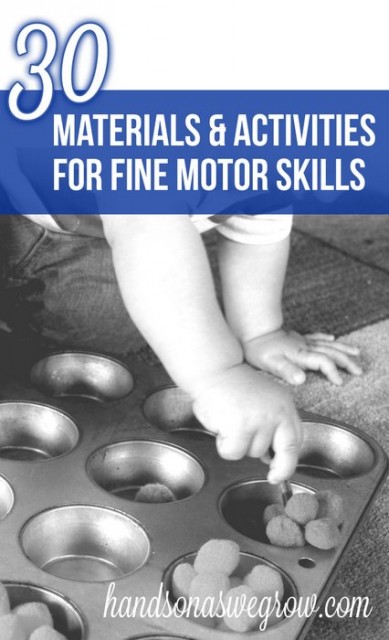
What a difference a year makes!
Last year, Henry wouldn’t sit still, or have any desire to do anything that didn’t involve a lot of running around. We were really into activities that promoted his gross motor skills at that time.
But recently, Henry’s taken a turn and likes to focus on some of these littler things.
He loves to cut especially.
Now that’s he’s interested in these fine motor activities, what can we do?
I’ve gathered up some inspiration."
Click on the name of each activity to get to the link on the web.

Some materials that promote fine motor skills, along with some activities to do with them!
materials that promote fine motor skills : | ||||||||||||||||||||||||||
|
Pom Poms hands on : as we grow | ||||||||||||||||||||||||||
|
Paper Clips Our Country Road | ||||||||||||||||||||||||||
activities that promote fine motor skills:
| ||||||||||||||||||||||||||
Subscribe to:
Posts (Atom)


